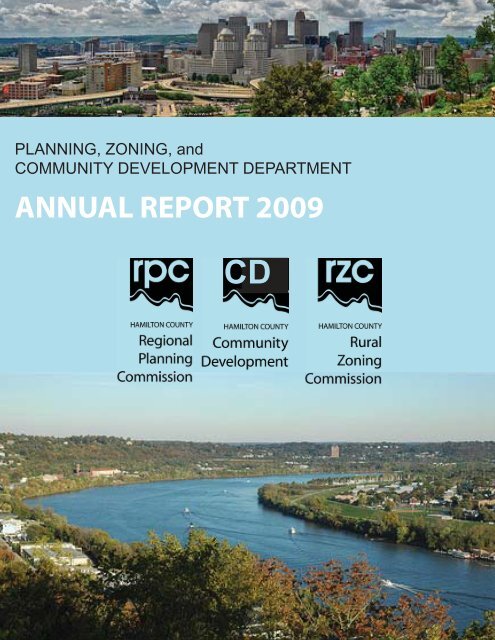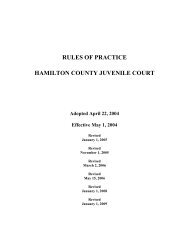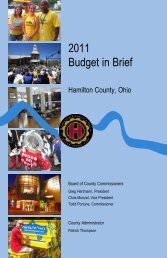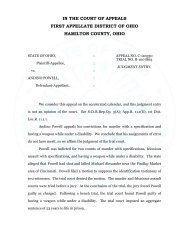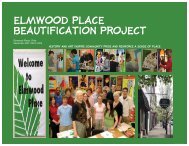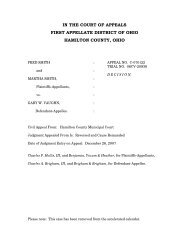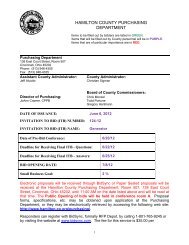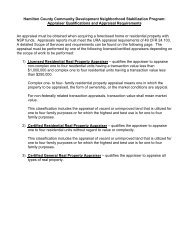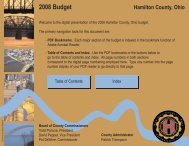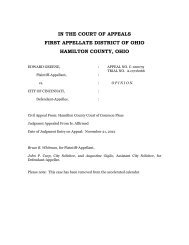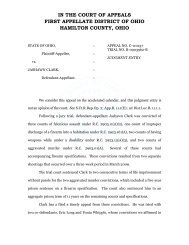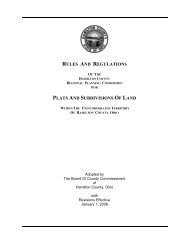Annual Report RPC/RZC/CD - 2009 - Hamilton County, Ohio
Annual Report RPC/RZC/CD - 2009 - Hamilton County, Ohio
Annual Report RPC/RZC/CD - 2009 - Hamilton County, Ohio
- No tags were found...
You also want an ePaper? Increase the reach of your titles
YUMPU automatically turns print PDFs into web optimized ePapers that Google loves.
PLANNING, ZONING, andCOMMUNITY DEVELOPMENT DEPARTMENTANNUAL REPORT <strong>2009</strong><strong>CD</strong>
Director's Message<strong>2009</strong> was a year ofsignifi cant transition forthe Regional PlanningCommissionTo Those We Serve:We are pleased to provide you with the <strong>2009</strong> <strong>Annual</strong> <strong>Report</strong> of <strong>Hamilton</strong> <strong>County</strong>’s Planning,Zoning and Community Development Departments and the commissions we served – <strong>Hamilton</strong><strong>County</strong> Regional Planning Commission, the Planning Partnership, and the <strong>Hamilton</strong> <strong>County</strong> RuralZoning Commission, the <strong>Hamilton</strong> <strong>County</strong> Board of Zoning Appeals, and the <strong>Hamilton</strong> <strong>County</strong>Board of Commissioners.With critical support of county commissioners, jurisdiction members, volunteers and our manyorganization partners, we are able to report another year of successes in our core functions of communityplanning, data products, development services (zoning and subdivision), zoning services(permits and enforcement), and community development (federal grants administration). Thissuccess, however, was accompanied by many organizational changes.Beginning in January, the Regional Planning Commission embarked on an internal departmentconsolidation process including the merging of the Planning, Zoning, Community Development,Building Inspections, and Public Works Departments into the new Planning & Development Department.Staff spent substantial time in department-wide meetings to consolidate policies, mergeorganization tables, and establish a single budget for this new department. A major component ofthis transition included converting the Regional Planning Commission staff to Board of <strong>County</strong>Commissioner employees.The goal of this consolidation is to create a single, high-performing, coordinated, efficient departmentto better serve residents and private industry in the development process. The formal launchof this consolidation in January aims to maintain the integrity of each separate department whilecreating coordinated, seamless integration of functions.Despite this time consuming effort, we continued to expand our partnerships in <strong>2009</strong> to assistcommunities in <strong>Hamilton</strong> <strong>County</strong> to plan in a comprehensive manner and to collaborate to achieveregional goals identified in COMPASS. In this report, you will find more information about progressbeing made on important implementation initiatives such as:• Government Cooperation and Efficiency Project• Transportation Policy Plan• <strong>Hamilton</strong> <strong>County</strong> Energy Efficiency & Conservation Block Grant• Communities of the Future Initiative (in collaboration with MSD)• First Suburbs Consortium• Planning Commissioners' Forum• APA Webinars• Contract ServicesThis report, as well as additional information about our work and progress, is available on our website at www.hamiltoncountyohio.gov/pd. We welcome your feedback, ideas, and suggestions abouthow we can better serve <strong>Hamilton</strong> <strong>County</strong> communities.We look forward to hearing from you.Best regardsTodd Kinskey, AICPDirector of Regional Planning
Table of ContentsPlanning Commission ...................................................................................................... 2Frank F. Ferris II Planning Award .................................................................................... 4Planning Partnership ........................................................................................................ 5Community Planning ....................................................................................................... 8Information Technology / Data Products .......................................................................14Development Review ..................................................................................................... 17Zoning Commission ....................................................................................................... 23Community Development...............................................................................................26Planning, Zoning, and Community Development 2010 Staff ........................................ 31<strong>2009</strong> Committees, Teams, and Board Memberships .......................................................32<strong>2009</strong> ANNUAL REPORTi
Planning Commission<strong>RPC</strong> VisionTo assist <strong>Hamilton</strong> <strong>County</strong> and its communities, agencies and citizens in planning andachieving sustainable development and related community and regional goals.HAMILTON COUNTYRegionalPlanningCommission<strong>RPC</strong> Mission• To build planning partnerships for creating and implementing community plans in thecontext of the region.• To provide data management and analysis for effective planning decision-making in<strong>Hamilton</strong> <strong>County</strong> governments.• To promote an equitable balance of local, county and regional perspectives and interestsin community planning forums.The <strong>Hamilton</strong> <strong>County</strong> Regional Planning Commission (<strong>RPC</strong>) is an alliance of local planningcommissions and governments that seeks to address mutual goals related to physical,economic, and social issues among the 49 communities within <strong>Hamilton</strong> <strong>County</strong>. <strong>RPC</strong>helps ensure that community trends are anticipated, challenges are addressed, prioritiesare focused, and our collective future is planned and achieved strategically.MembershipMembership in the <strong>Hamilton</strong> <strong>County</strong> Regional Planning Commission (<strong>RPC</strong>) is on anannual basis. In <strong>2009</strong>, thirty jurisdictions were members of the <strong>RPC</strong> paying fees totaling$52,943. Joint funding by local governments enables <strong>RPC</strong>'s staff to support local governmentsthrough:Networking and Lobbying• First Suburbs Consortium• Planning PartnershipCommittees - collective solutions to local issues• Government Cooperation and Efficiency Project• <strong>Hamilton</strong> <strong>County</strong> Climate InitiativeTechnical Assistance and Training• <strong>Hamilton</strong> <strong>County</strong> Data Center• Certified Planning Commissioners' ProgramCommunication• Community Action Network Directory• UPDATE NewsletterThe <strong>RPC</strong> provides advisory planning and development review services to the unincorporatedareas (12 townships) of the <strong>County</strong>. It also provides similar services upon requestto <strong>County</strong> municipalities that are members of the Commission and pay annual fees. TheCommission’s various planning activities include programs for subdivision compliance,community planning, development review and Census/data and information systems.2 HAMILTON COUNTY PLANNING, ZONING, AND COMMUNITY DEVELOPMENT DEPARTMENT
Planning CommissionThe Commission’s services are tied to annual work programs that monitor developmenttrends, evaluate current policies, and update the <strong>Hamilton</strong> <strong>County</strong> Master Plan and relatedregulations for zoning, subdivision of land and traffic circulation.The Commission is responsible for determining consistency of development proposalswith adopted plans for township areas. Land use control responsibilities also includedevelopment review for consistency with zoning regulations, subdivision rules, and thoroughfareplans. Staff makes advisory zoning recommendations to the <strong>Hamilton</strong> <strong>County</strong>Rural Zoning Commission and to township and municipal zoning commissions. The <strong>RPC</strong>administers and takes final actions on land subdivision for the entire unincorporated area.It coordinates the multi-agency review of subdivision plans and ensures conformity withthe <strong>County</strong>’s regulations.<strong>RPC</strong> prepares and disseminates information and maps on a variety of subjects related toplanning, and this information is available for public and agency use. It maintains Censusand other data on population, housing, zoning, building activity, socioeconomic development,school trends, and many physical and land use features. The staff coordinates andassigns street address numbers for the unincorporated areas and several municipalities. TheCommission’s staff also supports the various functions of the Rural Zoning Commission,the Planning Partnership, the Cincinnati Area Geographic Information System (CAGIS),the First Suburbs Consortium, and other boards, committees, and task forces.The <strong>Hamilton</strong> <strong>County</strong> Regional Planning Commission is a seven member board. Thecomposition of this Commission (whose members serve five-year terms) is as follows:PlanningCommissioners, <strong>2009</strong>• Donald Misrach(reappointed 2006, currentterm expires 2011)• Hal Franke(reappointed <strong>2009</strong>, currentterm expires 2014)• Melvin D. Martin(reappointed 2005, currentterm expires 2010)• John Linnenberg, Chair(reappointed April <strong>2009</strong>,current term expires 2014)• David Okum(re-elected 2006, currentterm expires 2011)• Larry Sprague(reappointed 2005, currentterm expires 2010)• Roxanne Qualls(appointed October 2007,current term expires 2011)• Four residents of the unincorporated area of <strong>Hamilton</strong> <strong>County</strong>, who are nominated byTownship Trustees and other interested parties, and appointed by the Board of <strong>County</strong>Commissioners• One resident of a City or Village with a planning commission, who is appointed by theBoard of <strong>County</strong> Commissioners• One resident of a City or Village with a planning commission, exclusive of Cincinnati,who is elected by mail ballot of municipal planning commissions• One resident of the City of Cincinnati appointed by the City of Cincinnati PlanningCommission<strong>2009</strong> ANNUAL REPORT3
Frank F. Ferris II AwardThe creation of the Frank F. Ferris II Planning Award by the <strong>Hamilton</strong> <strong>County</strong> RegionalPlanning Commission recognizes and honors the lifelong dedication of Mr. Ferris tomunicipal, county and regional planning activities. It publicly recognizes and promotesoutstanding contributions to community planning in <strong>Hamilton</strong> <strong>County</strong>. <strong>RPC</strong> presents theaward annually to a local planning commission or committee that best embodies planningideals and demonstrates civic, economic, aesthetic and environmental significance.The 2008 Frank F. Ferris II Planning Award (awarded in <strong>2009</strong>) was presented to the Cityof Cincinnati Climate Protection Steering Committee for its work on the Green CincinnatiPlan.Cincinnati is one of more than 1,000 U.S. cities that has committed to promote and implementclimate protection measures that can help conserve scarce natural resources, savemoney, enhance the local economy, improve air quality, create jobs, and improve publichealth.City administration, through the Office of Environmental Quality, developed the GreenCincinnati Plan (a Climate Protection Action Plan) with significant input from the community,including the Climate Protection Steering Committee. Composed of representativesof Cincinnati's business, government, environmental, academic, and civic organizations,the committee created five Task Teams of more than 150 subject matter experts and concernedcitizens in the areas of Energy, Transportation, Land Use, Waste Management,and Advocacy.Cincinnati Vice-Mayor DavidCrowley and Ginnell Schilleraccepted the Frank F. FerrisII Planning Award on behalf ofthe City of Cincinnati ClimateProtection Steering Committee4 HAMILTON COUNTY PLANNING, ZONING, AND COMMUNITY DEVELOPMENT DEPARTMENT
Planning PartnershipMissionTo bring together public, private and civic sector organizations engaged in communityplanning in <strong>Hamilton</strong> <strong>County</strong> so that mutual goals related to physical, economic and socialissues can be planned for comprehensively and achieved collaboratively.Government Cooperation and Efficiency Project (GCEP)GCEP is a voluntary effort designed to help local communities improve service deliveryand control costs through cross-jurisdictional cooperation, sharing of services and possibleservice delivery consolidation. GCEP is jointly funded by Hamitlon <strong>County</strong>, the City ofCincinnati, and the Cincinnati Business Committee.In <strong>2009</strong>, GCEP continued to work with Management Partners Inc. to make business casesfor moving forward with various shared service initiatives. They also focused on buildingcapacity of the Center for Local Government such that the Center can assume the role ofGCEP in the near future. Lastly, GCEP provide oversight for two grants awarded in 2008(totalling $122,000) from the <strong>Ohio</strong> Department of Development to study regional servicecollaboration. The final reports for these grants have yet to be released.HAMILTON COUNTYPlanningPartnership<strong>Annual</strong> MeetingThe <strong>2009</strong> Planning Partnership <strong>Annual</strong> Meeting took place on March 30, <strong>2009</strong> at RookwoodTower in Norwood. <strong>County</strong> Commissioner Greg Hartman welcomed participants stressingthe importance of collaboration and strategic partnerships to better serve our residents.ChairpersonChris BortzCity of Cincinnati RepresentativeThe keynote speaker was William Murdock, Director of the Urban Development Divisionof the <strong>Ohio</strong> Department of Development. Mr. Murdock talked about the programs availableto local communities such as Brownfield Redevelopment, Clean <strong>Ohio</strong> and Green SpaceConservation Programs, Historic Tax Credits and other resources of funding and creativeways of using them.APA WebinarsDuring <strong>2009</strong>, six online seminars organized by the American Planning Association werehosted by the HC<strong>RPC</strong>. These training opportunites were free and open to the public.Professional planners could earn up to a total of nine (9) credits (including 4.5 CM Lawcredits) toward AICP certificate maintenance. The APA is continuing the webinar seriesin 2010 and they will again be available for viewing at the HC<strong>RPC</strong> offices.<strong>2009</strong> Planning Commissioners' Forum Promotes Peer to Peer LearningThe <strong>2009</strong> Planning Commissioners' Forum was held November 7 at the Blue Ash RecreationCenter. The event, now in its fourth year, was organized by and for commissionersof local municipal and township members of the Planning Partnership. The success ofthe Forum lies in its fast pace, carefully selected discussion topics, and meeting design,which through small discussion groups, allows personal interaction.Chairperson-ElectRichard FinanMunicipal RepresentativeVice-ChairpersonAl PeterTownship Representative<strong>2009</strong> ANNUAL REPORT5
Planning Partnership<strong>2009</strong> JurisdictionMembersAddyston VillageAnderson TownshipArlington Heights VillageBlue Ash CityCheviot CityCincinnati CityCleves VillageColumbia TownshipCrosby TownshipDeer Park CityElmwood Place VillageEvendale VillageFairfax VillageForest Park VillageGlendale VillageGolf Manor VillageGreenhills VillageGreen Township<strong>Hamilton</strong> <strong>County</strong>CommissionersLockland VillageMadeira CityMariemont VillageMilford CityMontgomery CityNewtown VillageNorth Bend VillageReading CitySpringdale CitySymmes TownshipWoodlawn VillageWyoming CityThe keynote speaker for the <strong>2009</strong> event was Johnna Reeder from Duke Energy. Her presentationfocused on "smart" technology and sustainable energy practices being deployed.There were numerous opportunities for participants to engage in conversation and learnwhat their peers and neighboring communities are doing on issues of common interest.Some of the topics of the roundtable discussions were: A discussion on form basedcodes, "Is our community in compliance with the Fair Housing Act?," "Planning Commissions:The first in the line of fire." and "Is your community ready for deployment ofnew technology?"Communications and OutreachThe Planning Partnership strives to keep its members and other interested parties informedof events and issues relevant to their community planning practices. To that end, thePlanning Partnership publishes the quarterly newsletter UPDATE.The Planning Partnership Web site is located at www.hamiltoncountyohio.gov/hcrpc/partner. This site is user friendly, and includes a library and a calendar of events that isupdated daily.Program Committee Sets the Path for the 2010 Planning Partnership ForumSeriesIn <strong>2009</strong> the Program Committee reconvened focusing on identifying topics of interestby local communities. The group analyzed input provided at the <strong>Annual</strong> Meeting, feedbackfrom a questionnaire circulated through the Center for Local Governments, andresearch by committee members. As a result of this process, a three part series focusedon Sustainability emerged to be offered in 2010. The topics selected were (1) The BuiltEnvironment: Retrofitting Cities, Communities, Neighborhoods, (2) Reinventing Communitiesin a Changing Environment (the importance of walkability and connectivity foran aging population and for public health prevention), and (3) Financial Sustainability:Fiscal Impact of Land Use Policies/Models.Members of the Program Committee are: Michael Lemon (Columbia Twp.), Joanne Gerson(City of Montgomery), Stephanie Stoller (City of Blue Ash), Chad Edwards (EmersionDesign), and Alan Warner (GBBN Architects, Inc.).Transportation Policy PlanIn January <strong>2009</strong>, the <strong>Hamilton</strong> <strong>County</strong> Board of Commissioners passed a Resolutiondirecting the Regional Planning Commission staff to convene an ad-hoc TransportationPolicy Plan Committee. The purpose of the Committee was to identify key transportationissues, opportunities and risks, and to make recommendations as to how such issuescould be addressed by <strong>Hamilton</strong> <strong>County</strong> in such a fashion as to advance the transportationinterests of the <strong>County</strong>.With this direction, a committee representing a broad array of transportation interests6 HAMILTON COUNTY PLANNING, ZONING, AND COMMUNITY DEVELOPMENT DEPARTMENT
Planning Partnershipwas appointed and met a number of times over the course of the year. The Committeeagreed on several principles, which became the overarching themes or foundations of theproposed policy. Those principles were taken into context and reinforced each other asthey were weaved into the Goals of the Policy Plan:• Promote economic development and prosperity• Unify our voice in legislation and lobbying efforts• Promote cooperation, coordination and communication of organizations involved inallocation and distribution of funding• Coordinate regulations in <strong>Hamilton</strong> <strong>County</strong> and its jurisdictions• Promote rehabilitation of existing infrastructure first• Facilitate connectivity and mobility of people and goods and data/communication (withinthe <strong>County</strong>, with adjacent counties, to the nation, and to the world)• Promote energy conservation in all transportation projects and programs, especially bycapitalizing existing transportation and other infrastructure assets• Promote the evaluation and use/deployment of new technologies that will improve ourregion's transportation system• Utilize collaborative decision-making that seeks collaborative funding participationfrom private, public, and civic sector sourcesThe Plan is intended to apply to all transportation and related infrastructure in <strong>Hamilton</strong><strong>County</strong> that is supported or endorsed by the Board of Commissioners. The intended usersof the Plan include the Board of Commissioners, <strong>County</strong> Departments reporting tothe Board of Commissioners as well as those <strong>Hamilton</strong> <strong>County</strong> jurisdiction’s that chooseto follow the Vision and Goals of the Plan. The Draft will be submitted to the <strong>Hamilton</strong><strong>County</strong> Board of Commissioners in early 2010 for consideration and approval.<strong>2009</strong> ANNUAL REPORT7
Community PlanningObjectives:Prepare Strategic Plansfor Community COMPASSInitiativesBuild partnershipsfor implementation ofCommunity COMPASSDevelop implementationframeworksSupport economicdevelopment effortslocally and countywideGreenhills Comprehensive PlanA contract for technical services was signed at the end of 2008 between the Villageof Greenhills and the <strong>Hamilton</strong> <strong>County</strong> Regional Planning Commission (HC<strong>RPC</strong>) forthe preparation of a comprehensive plan. Working with a core 14 member committee,HC<strong>RPC</strong> staff led the preparation of the plan that culminated with the adoption by Councilon October 27, <strong>2009</strong>.The collective vision for the future of Greenhills has a multi-prong approach that buildson (1) the Village's historic past, (2) the respect of the natural environment, (3) creatinga friendly and collaborative atmosphere where residents are afforded opportunities forcommunity life and that, (4) creates an environment that is supportive of commercialactivity that provides financial stability and much needed products and services for thecommunity.Goals and strategies in the plan focus on Image, the Village Center, Community Life,Schools and Education, Open Spaces Recreation and Community Services, and on Redevelopmentand Economic Development Issues.As part of this intense planning effort, 25 meetings were facilitated by HC<strong>RPC</strong>, including16 meetings with the steering committee, 3 meetings with the Recreation Sub-committee,3 Community-wide meetings, and 3 Focus Group meetings (one each on Housing andHistoric Preservation, Greenbelt, and the Village Center).A project website was created http://www.hamiltoncountyohio.gov/hcrpc/greenhills/ andhosted by the HC<strong>RPC</strong> to ensure transparency and easy access by all to information andrecords related to this plan. Newspaper announcements, doorknob hangers, and announcementsin public and community gathering places were also used to keep residents abreastof progress on the plan.First Suburbs Consortium of Southwest <strong>Ohio</strong> (FSC-SW)HAMILTON COUNTYFirstSuburbsConsortiumFirst Suburbs shifted leadership personnel around with two retirements requiring newexecutive committee members. Chuck Kamine from Amberley Village and Richard Ellisonfrom Elmwood Place both left their elected positions at the end of <strong>2009</strong>. John Smithfrom Silverton, Dan Pillow from Addyston, and Mark Weber from Blue Ash volunteeredto serve on the executive committee for 2010 along with Jim O'Reilly (Wyoming), TomMoeller (Madeira), Gerri Harbison (Montgomery), and Jenny Kilgore (Glendale).First Suburbs closely watched and supported various legislative proposals in the GeneralAssembly dealing with property foreclosures and abandonment. The most promisingbill introduced in <strong>2009</strong> would expand the successful land bank system used by Cuyahoga<strong>County</strong> statewide. There is resistance to this from some county officials and state representatives,and First Suburbs needs to convince them of the need for land banking andgain their support for the legislation.8 HAMILTON COUNTY PLANNING, ZONING, AND COMMUNITY DEVELOPMENT DEPARTMENT
Community PlanningFirst Suburbs has worked hard with its collegues in Columbus, Cleveland, and Dayton topromote our agenda to General Assembly representatives and the Strickland administration.So far this effort thas not brought many tangible results, and work needs to be doneto more effectively communicate with our legislators.Active participation in First Suburbs decreased in <strong>2009</strong>, and the executive Committeewants to reverse this in 2010 through better communication with individual membercommunities and with the <strong>County</strong> Board of Commissioners.Firs Suburbs has a representative (Jim O'Reilly) on the I-75 Reconstruction Advisory Committee.This group has an important role in planning for massive traffic diversions thatwill result from I-75 construction. Over the lifespan of the project (2011 through 2018),many member jurisdictions in the Mill Creek Valley will be affected by increased trafficvolume, damages to roads and property, public safety costs from increased accidents, andimpact on overall quality of life.<strong>2009</strong> FSC-SW MembersAddyston Amberley Village Blue AshCheviot Colerain Township Deer ParkElmwood Place Evendale FairfaxForest Park Glendale Golf ManorGreenhills Lincoln Heights LocklandMadeira Milford MontgomeryMt. Healthy North College Hill ReadingSt. Bernard Silverton SpringdaleSpringfield Township Wyoming<strong>Hamilton</strong> <strong>County</strong> Bicycling Program (HCBP)The first full year for this program was a busy one. In August, <strong>Hamilton</strong> <strong>County</strong> togetherwith Cincinnati and First Suburbs filed an application for Bicycle Friendly Communitystatus with the League of American Bicyclists (LAB). This application resulted from thehard work bicycling advocates and local governments throughout the county, supportiveelected officials, and <strong>RPC</strong> staff.In February, <strong>Hamilton</strong> <strong>County</strong> hosted a bicycle friendly community workshop with representativesfrom LAB. Enthusiasm for the project from this event carried through intoBike Month in May, and lots of local bicycle touring events throughout the spring andsummer. Our team gathered an enormous amount of information about local cyclingconditions for our application, and LAB was impressed with our effort.HAMILTON COUNTYBicyclingProgram<strong>Hamilton</strong> <strong>County</strong> along with 17 other communities across the country received an "HonorableMention" designation. LAB provided a detailed critique of our application whichwe will use for our 2010 work program. Safe Routes to Schools, additional local touringevents, and adoption of bicycling policies are some of the recommendations from LAB.<strong>2009</strong> ANNUAL REPORT9
Community Planning<strong>RPC</strong> staff has roles with Queen City Bike, Cincinnati BikePAC, and the Cincinnati BikeMaster Plan steering committee.HAMILTON COUNTYClimateInitiative<strong>Hamilton</strong> <strong>County</strong> Climate Initiative (HCCI) / Energy Efficiency & ConservationBlock Grant (EECBG Formula)In <strong>2009</strong>, the <strong>Hamilton</strong> <strong>County</strong> Climate Initiative completed the last three public meetingswith participating <strong>Hamilton</strong> <strong>County</strong> jurisdictions. The meetings included the January 29meeting at the Colerain Township Senior Center on Energy, the February 27 meeting atBlue Ash Fire Station on Development and the April 22 Project Wrap-up Meeting at theSchott Center at the Cincinnati Zoo. Staff collaborated with Miami University EnvironmentalScience Masters' students in developing Green Guides for the four topic areasof Solid Waste/Fool Production, Transportation, Energy and Development. The GreenGuides contain "fast facts " about the topics (e.g., for Energy - Building "green" could cutCO2 emissions by 35% in North America (CEC, 2008). Actions for local governments,businesses, schools, individuals/households (e.g. for Energy for local government - giverecognition, awards, or incentives for energy efficient design in commercial buildingconstruction.) and WEB Resources with numerous links to information on the specifictopic areas. The Green Guides were developed to be easily accessible and thoroughinformation resources for all to use - downloadable from the HCCI web site http://www.hamiltoncountyohio.gov/climate/documents/.<strong>Hamilton</strong> <strong>County</strong> Solid Waste District staff developed twenty seven carbon calculators forpossible climate initiatives implemented by <strong>Hamilton</strong> <strong>County</strong> jurisdictions (e.g. implementpaper recycling in government buildings - the carbon calculator will take the number of tonsrecycled and estimate the annual reduction in CO2 equivalents). Planning staff developeda Master List of Strategies (e.g. for Development - (1) LEED Certification Tax Abatementfor all New Construction and Major Renovations, (2) Implanting transit-oriented development(TOD)) and a Green Credit Score Methodology/Carbon Calculator Summary Sheetfor the HCCI Web page Toolkit/Carbon Calculator. The HCCI Toolkit/Carbon Calculatorwas made available to all jurisdictions as a compact disc (<strong>CD</strong>).To enable the implementation of recommended climate initiatives, <strong>Hamilton</strong> <strong>County</strong> appliedfor and received an Energy Efficiency & Conservation Block Grant (EECBG) in theamount of $4,841,600 that will fund the following programs for three years:• $800,000 to the Greater Cincinnati Energy alliance for the energy audit and retrofitprogram for residential, small businesses and non-profit buildings• $1,873,000 to public buildings (other than <strong>County</strong> Buildings) for investment in thermaland energy efficiency improvements primarily through performance contracting• $1,100,000 to county building for investment in thermal and energy efficiency improvementsprimarily through energy performance contracting (EPC)• $126,602 to increase hybrid vehicle use in government fleets in the <strong>County</strong> - pays thedelta between costs of conventional vehicles and hybrids• $338,925 for other programs including energy efficiency (green jobs) skills training10 HAMILTON COUNTY PLANNING, ZONING, AND COMMUNITY DEVELOPMENT DEPARTMENT
Community Planningand certification, investigating property tax-based assessment and/or on-bill (e.g. Duke,Water) for paying for energy improvements over time at affordable rates, and planninga showcase project of energy efficient homes developed with smart grid and alternativeenergy technologiesIn November <strong>2009</strong>, <strong>Hamilton</strong> <strong>County</strong> hosted a kick-off meeting at the Wyoming CivicCenter for the <strong>Hamilton</strong> county jurisdictions to present and explain EECBG Formula GrantPrograms. At the meeting, representatives from Clean Energy Solution, Inc., the <strong>County</strong>'senergy efficiency consultants, presented the framework for the Grant's energy efficiencyprograms emphasizing the energy performance contracting program, Andy Holzhauser ofthe Greater Cincinnati Energy Alliance (GCEA) also presented an outline of the GCEAenergy audit and retrofit program targeted to <strong>Hamilton</strong> <strong>County</strong> residents, small businessesand non-profits. All told, representatives from 20 jurisdictions participated in themeeting. In December <strong>2009</strong>, <strong>Hamilton</strong> <strong>County</strong> collaborated with the Greater CincinnatiEnergy Alliance and other partners including the City of Cincinnati in the developmentof an Energy Efficiency & Conservation Block Grant - Competitive Grant Application inthe amount of $55 million. This Retrofit Ramp Grant will also include Kenton, Booneand Campbell Counties and the cities of Covington and Florence in Kentucky. The grantrequires a 5:1 local match - so the total expenditures from the grant will be more than$250 mission. If it's funded, the grant will enable GCEA to massively scale-up its energyefficiency retrofit program.<strong>Hamilton</strong> <strong>County</strong> Regional Planning Collaborates with Metropolitan SewerDistrict on Communities of the Future/Project GroundworkSince May of <strong>2009</strong>, <strong>Hamilton</strong> <strong>County</strong> Regional Planning Commission (HC<strong>RPC</strong>) staffhas been working on a contract to provide community analysis and outreach for the MetropolitanSewer District of Greater Cincinnati (MSD). This project was first identifiedas the green infrastructure project and now has been clarified as the Communities of theFuture Program. Communities of the Future is MSD's vision for the implementationof Project Groundwork, one of the largest public works projects in the history of ourmetropolitan region. Project Groundwork seeks to solve the long-term combined seweroverflow problem (CSO) - 14 billion gallons of raw sewage, mixed with stormwater,overflow from our sewers into local streams and rivers annually.As mandated by the Federal Consent Decree, MSD is committed to rebuilding our sewerinfrastructure and is planning to utilize new ways of thinking and new engineering solutionsthat are more energy efficient and have lower long-term costs. These solutionsinclude a mix of both "grey and green infrastructure." Grey infrastructure refers to newsewers, upgraded treatment plants and enhanced high-rate treatment facilities. Greeninfrastructure is designed to treat the problem at the source, by keeping stormwater outof combined sewers using best management practices such as pervious pavement, greenroofs, bio-retention basins and by enhancing nature's built-in capacity to handle stormwaterby restoring habitats, reforestation and "daylighting" urban streams (daylighting<strong>2009</strong> ANNUAL REPORT11
Community Planningstreams means to redirect a buried stream into an above-ground channel).MSD's broader vision called Communities of the Future recognizes the ability of newgreen infrastructure to create better places to live which MSD plans to leverage by workingwith other stakeholders engaged in community improvements. MSD also sees Communitiesof the Future as a way to actualize the "triple-bottom Line" of sustainable developmentby maximizing the social, economic and environmental benefits of ProjectGroundwork. To implement Communities of the Future, MSD is employing a four-stepprocess: 1. Compile and analyze existing data and information, 2. Identify opportunitiesand constraints to sustainable infrastructure solutions, 3. Develop solutions and an actionplan and 4. Evaluate feasibility and implement the vision.Planning staff has been instrumental in step one's data complementation and analysiswith the development of the South Fairmount-CSO#5 Urban Audit (September <strong>2009</strong>),which included a "boots on the ground' physical inventory with photographs of all buildingsand evaluations of all building structural conditions in the South Fairmount studyarea. The Audit also included CAGIS parcel data and Auditor data for all the properties.Staff also completed the Lower Mill Creek Course Evaluation Planning Background<strong>Report</strong> (January 2010) which was an investigation of recent planning efforts, socio-economictrends and historical, community and natural resources in the sub-basins of theLower Mill Creek.<strong>Hamilton</strong> <strong>County</strong>Climate Initaitive:Inventory of 132 GreenProjectsI-275I-75I-71I-74Green Inventory SitesMunicipalities & TownshipsPrimary Roads<strong>Ohio</strong> River<strong>Hamilton</strong> <strong>County</strong> Climate Initiative:Inventory of 132 Green ProjectsI-27512 HAMILTON COUNTY PLANNING, ZONING, AND COMMUNITY DEVELOPMENT DEPARTMENT
Community PlanningEarly small phases of Project Groundwork, called Early Success Projects, are beingdesigned to educate the community about sustainable stormwater management andwill provide the community with attractive public amenities such as rain gardens andbio-swales, and will prepare them for larger green infrastructure projects in the future.HC<strong>RPC</strong> assisted MSD with this phase by finding and completing an EPA Surface WaterImprovement Funds Grant, which if successful, will partially offset the costs of one ofthe first Early Success Projects.Community COMPASSFollowing community review and a public hearing by the Regional Planning Commissionin 2008, the Board of <strong>County</strong> Commissioners approved a Resolution on February18, <strong>2009</strong> adopting the Community COMPASS Vision Update. The Vision and HighPriority Initiatives, approved originally in 2003, remained largely the same except thatsome emerging planning issues were added to the priority initiatives list to reflect thecurrent work program of staff.<strong>2009</strong> ANNUAL REPORT13
Information Technology / Data ProductsObjectives:Maintain <strong>RPC</strong>/<strong>RZC</strong>/BZA network and "HelpDesk" functions as wellas Special Requests /ProjectsMaintain CAGIS databaseOrganize, analyze anddistribute 2000 CensusData, internal and externalrequests for data analysisand maps and support forongoing Census activitiesDesign and maintainan easy navigated andunderstandable web sitethat connects citizens toinformation and servicesprovided by the <strong>County</strong>Geographic Information AnalysisThe Data Products Section prepares maps and analyses for both internal county customersand the general public for a diverse list of topics. Examples include:• as an ongoing project with the <strong>County</strong> Prosecutor's Office, updates to school, daycare and preschool locations and 1,000 ft. buffer surrounding properties continued in<strong>2009</strong>• inventorying food and physical activity facilities, and analyzing walkability data for<strong>Hamilton</strong> <strong>County</strong> Health District <strong>2009</strong> Healthy Living Project in Woodland, OH; developeda GIS application for use in all of <strong>Hamilton</strong> <strong>County</strong>; designing a geodatabasefor the South Fairmount-CSO#5 Urban Audit project; assisting in field collection ofdata• updated CAGIS data for <strong>RPC</strong> and <strong>RZC</strong>; organized and documented datasets and metadatafor inclusion in CAGIS; updated zoning in <strong>Hamilton</strong> <strong>County</strong>• data analysis for <strong>Hamilton</strong> <strong>County</strong> Small Business Development regarding The Banksworker's residence in the 15 county CMSA, three state region, and the United States• testifying in court for the <strong>County</strong> and City Prosecutor regarding accuracy of CAGIS,signing affidavits regarding CAGIS measurements• Analyzed data and prepared maps for the Southwest <strong>Ohio</strong> Council on Aging for a 2008transportation needs assessment• inventorying projects, facilities, and private businesses that fit into the <strong>Hamilton</strong> <strong>County</strong>Climate Initiative plan and producing a map for the web site (see map on page 12)Information TechnologyEvery year has its defining events, and <strong>2009</strong> was indeed a busy year.Bob Eaton, the Regional Planning Commission System Administrator, retired after over20 years with <strong>Hamilton</strong> <strong>County</strong>. Bob was an Information Technology pioneer who createda sophisticated, efficient computer network for HC<strong>RPC</strong> that served as a model forother departments. Chris Porter, formerly the <strong>Hamilton</strong> <strong>County</strong> Web Developer, tookBob's position after several months working together to make a smooth transition. Chrisis now Planning & Development Information Systems Manager. John Huth took overChris' duties as web developer.Chris' job immediately became much more complicated when <strong>RPC</strong> merged with fourother departments into the <strong>Hamilton</strong> <strong>County</strong> Department of Planning & Development.Chris is now responsible for integrating the independent systems from these differentdepartments into one large network. Challenges of doing this include various networkupgrades and migrating users into one Active Directory Organizational Unit for logonand security purposes.John Huth, our new web developer, is also very busy developing and learning the new webtechnologies, and continues to serve more than 35 departments with various web functions.John is doing all of this along with managing various Census 2010 projects.14 HAMILTON COUNTY PLANNING, ZONING, AND COMMUNITY DEVELOPMENT DEPARTMENT
Information Technology / Data ProductsPlanning & Development Information Technology team (formerly Regional PlanningCommission) continues to create and maintain, under many different formats, the <strong>County</strong>web site. The newly rolled-out pages include the <strong>Hamilton</strong> <strong>County</strong> volunteers and the<strong>Hamilton</strong> <strong>County</strong> Bicycling Program. There are several reconfigured web pages as welland they include the First Suburbs and the <strong>Hamilton</strong> <strong>County</strong> Working Families.P&D Information Technology Team is also charged with the responsibility of maintainingand upgrading the <strong>County</strong>'s web servers. These include the two main web servers, anintranet server, a staging server, and two database servers. Several system improvementswere implemented during <strong>2009</strong> in order to increase performance and reliability.• Migration of the database tables to the new server and SQL Server upgrades• Developing and deploying a backup strategy that includes a new Storage ServerWe also maintain 24/7 monitoring which allows P&D staff to be notified of impendingissues. This includes after-hours coverage by a consultant team in case of emergenciesoutside normal office hours. Backup and virtualization setup serves as the source fordisaster recovery as well as recovering individual files or folders.P&D Information Technology also continues to provide design and technical expertise toagencies and departments outside the Board of <strong>County</strong> Commissioner.Demographic Analysis<strong>Hamilton</strong> <strong>County</strong> was on pace to dip below 800,000 people by the Census 2010 count.However, the Census Bureau's 2008 estimate reveals that <strong>Hamilton</strong> <strong>County</strong> has increasedslightly from year 2000 to 851,494 people in 2008. American Community Survey datareveals between the years 2000 and 2008, the White population declined - 11,412 (+ / -1,077) while Black or African Americans increased 8,852 (+ / - 1,842), Asians increased1,179 (+ / - 573) and Hispanic/Latino population increased 5,579.Other American Community Survey data reveals that between 2000 and 2008 the numberof married couple families in the county decreased -15,208 (+ / - 2,031) while householdsizes and family sizes increased. The number of renter-occupied houses decreased over16,000 units while the number of vacant housing units grew. Housing value increasedand <strong>Hamilton</strong> <strong>County</strong> residents spent a larger percentage of their income on their housingcosts. The unemployment rate grew 1.7% while the Educational Services, Health Care andSocial Assistance Industry employed close to 10,000 people within 8 years. The medianhousehold income increased over $8,000 while the poverty rate grew 15.3%.Despite this estimated population growth, <strong>Hamilton</strong> <strong>County</strong> public school enrollmentcontinues to shrink. Between 2008 and <strong>2009</strong>, the public school population dropped over500 students. Within the last 30 years, the public school enrollment has dropped over45,000 students.<strong>2009</strong> ANNUAL REPORT15
Information Technology / Data ProductsThe most recent <strong>County</strong> Business Patterns released by the US Census Bureau reveal<strong>Hamilton</strong> <strong>County</strong> losing 470 business establishments and 4,964 jobs between 2006 and2007. However, within that same period, the average salary increased $1,109 (inflationadjusted), a figure higher than Butler, Clermont and Warren Counties. As displayed inmore detail below, Zip Code Business Patterns data reveals several areas adding in jobsbetween 2006 and 2007.Gearing up for Census 2010, the Regional Planning Commission participated in the LocalUpdate of Census Addresses (LUCA) Program. The Census Bureau approved and added5,760 addresses to their list. In addition, working under the Bureau's New ConstructionProgram, over 250 new homes were added to the list. Staff worked with the City ofCincinnati in the Participant Statistical Areas Program (PSAP). Census Tracts were splitand consolidated to meet target population ranges. Census block groups were realignedto match up with City of Cincinnati Neighborhood boundaries. New Census DesignatedPlaces (<strong>CD</strong>Ps) were created to blanket all portions of the incorporated areas of <strong>Hamilton</strong><strong>County</strong>.EmployeesChange 2006-200716 HAMILTON COUNTY PLANNING, ZONING, AND COMMUNITY DEVELOPMENT DEPARTMENT
Development ServicesDevelopment ServicesThe primary role of the Development Services Team is to coordinate the review ofproposed developments and plans that require approval by the Regional Planning Commission,Rural Zoning Commission and/or Board of <strong>County</strong> Commissioners. Thisreview requires communication with a multitude of stakeholders, including developers,engineers, architects, attorneys, property owners, development review agencies, electedofficials, township representatives, and the general public. This team strives to balancethe common good with the rights of private property owners while assuring compliancewith established development standards. The various tasks of the Development ServicesTeam are summarized below.Zoning ReviewIn <strong>2009</strong>, staff processed 59 zoning cases. Of these, 10 were zone amendments in townshipsthat have local zoning control where the <strong>RPC</strong> is required by state law to make arecommendation. Another 21 were cases reviewed for the Symmes Township Board ofZoning Appeals and Zoning Commission and the Village of North Bend Planning Commissionas part of contracts to administer zoning in these areas. The remaining 19 caseswere located within the territory covered by the <strong>Hamilton</strong> <strong>County</strong> Zoning Resolution andincluded zone amendments, planned unit developments, and various other developmentreview cases that required approval of the <strong>Hamilton</strong> <strong>County</strong> Rural Zoning Commission,Board of Zoning Appeals, or Board of <strong>County</strong> Commissioners.Objectives:Process and completeall development reviewapplications - zoneamendments, PUDs,conditional uses, land useplans & SPI reportsReview and processmajor/minor subdivisionsin compliance with ORCand <strong>Hamilton</strong> <strong>County</strong>RegulationsProvide addressassignment forunincorporated <strong>Hamilton</strong><strong>County</strong> and communitiesunder contract with theBuilding Department asneededSubdivision AdministrationThe primary role of Subdivision Administration is to review new preliminary subdivisionplans. This requires staff to determine compliance with subdivision regulations andother adopted plans, coordinate cross-agency review, and prepare maps and staff reportsfor Planning Commission meetings. Staff is also responsible for overseeing the ImprovementPlan and Record Plat approval process for each approved subdivision. Otherduties related to Subdivision Administration include review and approval of minor subdivisions(lot splits), assignment of addresses for all property in the unincorporated areasof <strong>Hamilton</strong> <strong>County</strong> and some incorporated jurisdictions, and providing consultation servicesfor landowners. In <strong>2009</strong>, the <strong>RPC</strong> approved 2 new major subdivisions containing44 lots and 11 minor subdivisions containing 23 lots for a total of 67 new lots availablefor development in the unincorporated portion of <strong>Hamilton</strong> <strong>County</strong>.Land Use Plan AdministrationThe Development Services Team is also responsible for the review and maintenance ofadopted comprehensive and land use plans in <strong>Hamilton</strong> <strong>County</strong>. Staff reviewed 7 LandUse Plan requests in <strong>2009</strong>, which included plan amendments and whole township updates.Staff annually prepares a report detailing the status of adopted plans, corresponds withtownship officials regarding plan status, and reviews submitted plans and plan updates<strong>2009</strong> ANNUAL REPORT17
Development ServicesScope of DevelopmentServices• Zone Amendments• Planned UnitDevelopments• Zoning Compliance Plans(Final Development Plan)• Major Adjustments orModifications• Minor Adjustments• Board of Zoning Appealsreportsfor presentation to the Regional Planning Commission. The plans adopted by the commissioninclude:Anderson TownshipAdopted Land Use Plans for Anderson Township include: the Beechmont Avenue LandscapePlan (2002), <strong>Ohio</strong> Riverfront Area Proposed Land Use Plan (2002), AndersonTownship Revised Sidewalk Plan (2004), the Beechmont Corridor Study Update (2006),the Beechmont Corridor Vision Plan (2006), and the Clough Pike Business District Plan(2007), and the Anderson Trails/Walkways Plan Update (<strong>2009</strong>). <strong>RPC</strong> also adopted aComprehensive Plan for the Township, including a township-wide land use plan, in 2005.The Township has begun the review and update process for the Comprehensive Plan andwill likely have an updated plan for <strong>RPC</strong> consideration in 2010.Colerain TownshipThe Colerain Township Trustees passed a resolution in 2003 appointing the Colerain TownshipZoning Commission as the Township planning authority. The Township requestsLand Use Plan recommendations from <strong>RPC</strong> staff, but does not request final adoption by<strong>RPC</strong> after approval by the Township Trustees. As a result, the Colerain Township LandUse Plan adopted by <strong>RPC</strong> has not been updated by <strong>RPC</strong> within the last five years and isno longer considered current according to <strong>RPC</strong> Bylaws.Columbia Township<strong>RPC</strong> adopted a Comprehensive Plan for Columbia Township in 2005. The ComprehensivePlan includes a Township-wide land use plan. The Township has also created SpecialPublic Interest (SPI) Strategy documents for the Plainville Road Corridor and the Ridgeand Highland areas to improve the functionality and design of both areas. The PlainvilleRoad Corridor SPI Strategies Plan and the Ridge and Highland SPI Strategies Plan wereboth adopted by <strong>RPC</strong> in 2006.Crosby TownshipThe Crosby Township Land Use Plan, completed by Township officials in June 2003,was adopted by <strong>RPC</strong> in 2004. The Plan encompasses the entire Township. An updatedplan has been approved by the Township Trustees and will likely be considered by <strong>RPC</strong>in 2010.Eastern Corridor Land Use Vision Plan (ECLUVP)The ECLUVP was adopted by <strong>RPC</strong> in 2002 as a guide for future Land Use Plans andother matters submitted to <strong>RPC</strong> for consideration. This plan is an advisory guide andframework for the Eastern Corridor area and does not require <strong>RPC</strong> consistency on a lotby-lotbasis.18 HAMILTON COUNTY PLANNING, ZONING, AND COMMUNITY DEVELOPMENT DEPARTMENT
Development ServicesGreen TownshipThe Green Township Land Use Plan Update was adopted by <strong>RPC</strong> in 2005. The documentincludes the township land use goals, strategies, objectives, and future land use plan map.Amendments approved since adoption include Edgewood Medical (2005), Stroschen Office(2006), Legacy Place Retail (2006), Boomer & Edgewood Office (2006), Harrison &Drew Retail (2006), Hillview Residential (2007), Bridgetown & Beihl Office (2007), 5470Rybolt Road (2007), and Chatwood Office (2008), West Fork Institutional (<strong>2009</strong>), 6946Harrison (<strong>2009</strong>), Cloverleaf Attached (<strong>2009</strong>), Mercy Hospital (<strong>2009</strong>), and 5458 RyboltRoad (<strong>2009</strong>). The township has initiated the process of updating the Land Use Plan andhas hired the Development Services Team to facilitate the update process. The updatedplan will likely be approved by the Township and considered by <strong>RPC</strong> in 2010.<strong>Hamilton</strong> <strong>County</strong> 2030 Plan and Implementation FrameworkSince the year 2000, <strong>RPC</strong> has been in the process of completing various componentsof a comprehensive plan for the future of <strong>Hamilton</strong> <strong>County</strong>. One of the main results ofthis process has been the completion of the 2030 Plan and Implementation Framework.Created with extensive citizen input, the plan contains: the Vision, Initiatives, Strategiesand Implementation Status; Policy Plan; 2030 Concept Plans for <strong>County</strong>wide Systems;Implementation Campaigns; and Performance Development - Milestones, Products, andSchedule. The plans were adopted by <strong>RPC</strong> in 2003 and updated in <strong>2009</strong>.Harrison TownshipThe Harrison Township Comprehensive Plan 2020 was initially adopted by <strong>RPC</strong> in 2001.The Township Trustees completed a review of the plan in 2006 and submitted the requiredUpdate/5 Year Review. The Update was adopted by <strong>RPC</strong> in 2006. Additionally, <strong>RPC</strong>adopted SPI Strategies Plans in 2006 that aim to encourage implementation of the ComprehensivePlan goals for southeastern Harrison Township.Miami TownshipThe most recent review and update of the Miami Township Land Use Policy and StrategyPlan was adopted by <strong>RPC</strong> in <strong>2009</strong>. The Township worked with staff of the DevelopmentServices Team to complete this update. The plan includes land use maps and policies forthe entire township.Springfi eld TownshipA Comprehensive Land Use Plan Update for the entire Township was adopted by <strong>RPC</strong> in2004. This plan includes detailed land use recommendations for the township and includesfuture land use plan maps. Staff has been in contact with township officials regardingcompletion of an update to the plan. The process for completing the necessary updatewill likely begin in 2010.<strong>2009</strong> ANNUAL REPORT19
Development ServicesSycamore TownshipA comprehensive update for the entire Township Land Use Plan was adopted by <strong>RPC</strong>in 2003. One amendment to the land use plan map (Pine Road Office) was adopted by<strong>RPC</strong> in 2003. A detailed review of the plan is currently required. The township is in theprocess of completing the necessary update and will submit the new plan for adoption by<strong>RPC</strong> as soon as it is completed.Symmes TownshipThe most recent Update/5 Year Review of the Symmes Township Land Use Plan wasadopted by <strong>RPC</strong> in <strong>2009</strong>. The township worked with staff of the Development Servicesteam and consultants to complete both a new Comprehensive Plan for the entire townshipand an update to the current Land Use Plan document.Western <strong>Hamilton</strong> <strong>County</strong> Collaborative Plan (WHCCP)The WHCCP was adopted by <strong>RPC</strong> in 1999 as a guideline for the future development of10 Western <strong>Hamilton</strong> <strong>County</strong> jurisdictions. It was amended in 2000 to reflect changes inthe Land Use Concept Map, and in 2002 to reflect the addition of new Action StrategyAlternatives to the Plan. This plan provides an advisory guide and framework for developmentin the western portion of the county and does not require <strong>RPC</strong> consistency on alot-by-lot basis.Development Services Highlights and AccomplishmentsIn addition to the core services already identified, the Development Services Team participatesin numerous other planning efforts throughout the county. Staff also provides forfee services through contracts with jurisdictions within the county, coordinates specificplanning projects, and offers support to volunteer planning organizations. Major projectsand accomplishments completed by the Development Services staff are included below.Mariemont North Square District StudyStaff obtained a contract with the Village of Mariemont to provide planning services forreview of existing zoning regulations and recommendations for improvements neededto allow appropriate redevelopment within the village. The main issue identified duringpreliminary meetings with village officials was that the existing zoning code did not containa district that would allow the construction of new-urbanist residential or mixed-usedevelopments. Staff conducted a review of existing regulations, the original plans for thecreation of Mariemont, and previous development proposals and presented preliminaryfindings at a public meeting and workshop held in the village in 2008. Comments andconcerns gathered at the meeting were then used to create a draft set of zoning text amendments,including the creation of a new mixed-use zoning district. The final recommendationswere presented to the village in January <strong>2009</strong>. A variation of the recommendationswas ultimately adopted by the village and are now included in the Mariemont ZoningOrdinance.20 HAMILTON COUNTY PLANNING, ZONING, AND COMMUNITY DEVELOPMENT DEPARTMENT
Development ServicesGreenhills Comprehensive PlanStaff assisted the Community Planning section in administration of a contract with theVillage of Greenhills to prepare a comprehensive plan. Staff of the Development ServicesTeam assisted in the preparation of documents, graphics, and maps, maintenanceof the project web site, and facilitation of public meetings. The comprehensive plan wascompleted and adopted by the Village of Greenhills in <strong>2009</strong>.Green Township Land Use Plan Update 2010Staff prepared and finalized a contract with the Green Township Trustees to provide professionalplanning recommendations and facilitation of the latest Green Township Land UsePlan update process. The process will officially begin in January 2010 with an expectedcompletion in May. Tasks will include review and revision of the existing maps and text,suggestions for changes, coordination of the Green Township Land Use Planning Committeemeetings, preparation of a draft of the committee recommendations, facilitationof a public open house meeting to review recommendations, and presentation of the planto the Green Township Trustees.Building and Development Consolidation ProjectStaff participated in the consolidation of the Planning and Zoning, Community Development,Building Inspections, and Public Works Departments into the new Planning andDevelopment Department. Staff attended department wide meetings, review proposedconsolidated policies and organizational tables, and helped ensure a smooth transitionperiod.APA-OH World Town Planning Day CharretteStaff worked with a subcommittee of the Cincinnati Section of the American PlanningAssociation - <strong>Ohio</strong> to plan and conduct the <strong>2009</strong> World Town Planning Day Charrette inthe City of Middletown on November 6, <strong>2009</strong>. Staff work included participation in thecommunity selection process, web site design/maintenance, event notification, solicitationof participants, and facilitation of the event. The focus of the event was on the potential3C Passenger Rail station in Middletown. The participants included professional planners,planning students, City officials, and others who were broken into four groups tostudy various aspects of the issue. These groups included land use around the station,connecting the station to downtown Middletown, connectivity to surrounding communities,and design of the station. Recommendations were presented to city officials at theend of the process.Foreclosure MappingStaff collected foreclosure data for 2008 and <strong>2009</strong> for the purpose of creating a map detailingthe location and potential concentration of foreclosures in <strong>Hamilton</strong> <strong>County</strong>. The datawas checked for quality, edited to remove duplications and converted to a database format.The data was then geocoded and mapped using the county GIS system. This informationwas created to assist the Community Development department in administering the U.S.<strong>2009</strong> ANNUAL REPORT21
Development ServicesDepartment of Housing and Urban Development (HUD) Neighborhood StabilizationProgram (NSP). However, the mapping project was so useful that additional maps havebeen requested by numerous other jurisdictions within the county. Maps were preparedfor Mount Healthy, Silverton, Colerain Township, and Golf Manor, among others.Stable Integrated Communities Mapping ProjectStaff updated maps for use in collaboration between the Data Products section and theUS Census Bureau showing integrated communities since 1970.MSD Green Infrastructure AssistanceStaff assisted the Community Planning section and MSD in the creation of a series of mapsfor use in the CSO#5 (Lick Run) green infrastructure program. Maps were consideredfor promotional material and future reports as part of the ongoing contract to provideassistance to MSD.22 HAMILTON COUNTY PLANNING, ZONING, AND COMMUNITY DEVELOPMENT DEPARTMENT
Zoning Commission<strong>RZC</strong> VisionTo have all development in compliance with <strong>Hamilton</strong> <strong>County</strong> zoning regulations aswell as consistent with the land use goals and objectives of the region and each affectedtownship.<strong>RZC</strong> MissionTo administer and enforce the zoning regulations adopted by the Board of <strong>County</strong> Commissionersand the citizens of <strong>Hamilton</strong> <strong>County</strong> while continually improving publicawareness and understanding of the importance of zoning in protecting public health,safety and welfare as well as private property. The Rural Zoning Commission (<strong>RZC</strong>)serves the Board of <strong>County</strong> Commissioners by administering and enforcing zoning infour townships and by providing contract services to a number of townships and villagesin <strong>Hamilton</strong> <strong>County</strong>.The Zoning Resolution is interpreted and enforced by the office of the <strong>County</strong> ZoningInspector. Duties of the <strong>RZC</strong> administrative staff and Zoning Inspectors include:• Administration of the Board of Zoning Appeals cases• Coordinating zoning amendment review and scheduling of public hearings• Presenting amendment and other zoning requests before the Regional Planning Commission,Rural Zoning Commission, Board of Zoning Appeals, and Board of <strong>County</strong>Commissioners• Maintaining official maps and files• Assisting the public with zoning information• Reviewing all building permits for zoning compliance• Issuing zoning certificates and final zoning inspections certificates for all buildingpermits• Conducting field inspections on reported zoning violations• Abating zoning violations through due process• Maintaining complaint and abatement records• Updating the zoning regulationsThe five members of the <strong>Hamilton</strong> <strong>County</strong> Rural Zoning Commission are appointed bythe Board of <strong>County</strong> Commissioners for a five-year term. The members must reside inan area under the jurisdiction of <strong>County</strong> zoning. In 2004 the Board of <strong>County</strong> Commissionersvoted to include an alternate on the Rural Zoning Commission.Zoning CertificatesIn <strong>2009</strong>, <strong>RZC</strong> staff issued a total of 698 zoning certificates. Of that total, 479 were locatedin areas governed by the Rural Zoning Commission (<strong>RZC</strong>) and 219 certificates were inHAMILTON COUNTYRuralZoningCommissionZoning Commissioners,<strong>2009</strong>• Robert PolewskiResident of MiamiTownship (reappointed2003)• Joel Cornelius,Resident of HarrisonTownship (appointed2005)• Christian JamesResident of MiamiTownship (appointed2005)• Susan Olson,Alternate, Resident ofColumbia Township (reappointed<strong>2009</strong>)• David Steinriede,Vice Chair, Residentof Green Township(appointed 2006)• Jerry Thomas, ChairResident of GreenTownship (appointed2005)<strong>2009</strong> ANNUAL REPORT23
Zoning Commissiontownships or jurisdictions that contract zoning review services through the Local ZoningAssistance Center (LZAC).In areas governed by the <strong>RZC</strong>, residential accessory structures, including fences, walls,swimming pools, decks, detached garages, and sheds ranked as the highest number ofzoning certificates issued with a total of 213. Attached/detached single family dwellingunits were the second highest number of zoning certificates totaling 76. Staff issued atotal of 38 zoning certificates for residential additions and 14 revisions to previously issuedzoning certificates. Combined commercial applications including new buildings,building additions, new tenant, alterations, etc., totaled 65 zoning certificates. There were73 sign permits issued.Zoning CertificateActivity, <strong>2009</strong><strong>Hamilton</strong> <strong>County</strong> Zoning JurisdictionsContract Zoning JurisdictionsIn zoning plan review contract areas. accessory structures, including fences, walls swimmingpools, decks, detached garages, and sheds also ranked as the highest number ofresidential zoning certificates issued with a total of 72. There were 14 new single familydwellings reviewed and issued by staff. Residential additions totaled 12 and revisions to previouslyissued certificates9. Combined commercial70applications including new60buildings, additions and alterationstotaled 39 with 73sign certificates issued.Number of Certificates50403020100Jan Feb Mar Apr May June July Aug Sept Oct Nov DecIn addition to the dailyroutine of reviewing siteplans and issuing zoningcertificates, zoning staffmembers respond to phoneand e-mail requests for zoninginformation, maintainand digitize zoning files,scan and digitize all zoningcertificates, issue all housenumbers.Board of Zoning AppealsIn an attempt to reduce costs, the Board of Zoning Appeals Department was abolished in<strong>2009</strong>. The staff of the Rural Zoning commission assumed the responsibility for administeringthe Board of Zoning Appeals including coordinating, scheduling and processingof all variance, conditional use, compatible nonconforming use and zoning appeals cases.The Board of Zoning Appeals heard 25 cases in <strong>2009</strong> including: 7 cases in ColumbiaTownship, 10 cases in Green Township, 4 cases in Harrison Township and 4 cases inMiami Township.24 HAMILTON COUNTY PLANNING, ZONING, AND COMMUNITY DEVELOPMENT DEPARTMENT
Community DevelopmentZoning EnforcementThe <strong>Hamilton</strong> <strong>County</strong> Rural Zoning Commission enforces the zoning regulations withinfour townships. However, through the Local Zoning Assistance Center (LZAC), the zoninginspectors enforce nuisance ordinances and zoning regulations in seven additionalcommunities.The type of zoning violations the zoning inspectors investigated this past year included inoperativevehicles (junk vehicles), fences, sheds and other accessory structures improperlylocated or without zoning certificates, signs, home occupations, lighting, nonconforminguses, and noise complaints. In <strong>2009</strong>, zoning enforcement staff conducted 4,214 zoningviolation investigations, resulting in 1,857 zoning violation notices sent to the propertyowners. There were 1,671 violations abated within 30 days of the first notice, and out ofthe remaining 186, only 48 resulted in issuing zoning violation citations.Other activities of the zoning inspectors include the inspection of new construction andannual inspections of all Planned Districts to assure zoning compliance. The majority ofzoning certificates issued in <strong>2009</strong> required more than one or two site inspections. Fromthe 698 zoning certificates issued, 674 zoning certificate field inspections were conducted.In addition, inspectors integrated field inspections with the Permits Plus computer programminglinked into the CAGIS system to allow for the tracking of enforcement and thelocation of groups of problem properties.Local Zoning Assistance CenterThe Local Zoning Assistance Center (LZAC), is designed to assist cities, townships, andmunicipalities in the daily operation and enforcement of locally adopted zoning regulations.By using the services of LZAC, participants can realize a significant cost savings whileproviding individuals in their community the benefit of an experienced, full-time staff.LZAC is staffed by a team of seven employees: the zoning administrator, one certifiedland use planner, two plans examiners, one technical/clerical specialist and two enforcementinspectors. <strong>RZC</strong> has been providing zoning services to the unincorporated areaof <strong>Hamilton</strong> <strong>County</strong> since the adoption of zoning in 1949 and zoning services throughLZAC since 1996. Many of the zoning and land use services available today are based oninformation in the Cincinnati Area Geographic Information System (CAGIS). The staffof LZAC works with jurisdictions to design a zoning administration and enforcementprogram tailored to meet their specific needs and goals.<strong>County</strong> ZoningJurisdictionsColumbia TownshipGreen TownshipHarrison TownshipMiami TownshipContract Service AreasSymmes TownshipComplete ServicesDelhi TownshipEnforcementNortheast Green TownshipEnforcementMiami TownshipNuisance AbatementCrosby TownshipNuisance AbatementHarrison TownshipNuisance AbatementWhitewater TownshipNuisance AbatementType of ServicesProvided by the LocalZoning AssistanceCenter• Zoning certificate reviewand issuance• Verbal and writtencorrespondence relatedto zoning regulations andinquiries• Field inspection and codeenforcement• Maps, mailing andpresentation graphicsrelated to zoning appeals,variances or zone changerequests• Preparation of zoning textamendments and relateddocuments, research andreports<strong>2009</strong> ANNUAL REPORT25
Community Development<strong>CD</strong> MissionTo provide quality housing as well as community and economic development opportunitiesto disadvantaged families and individuals in <strong>Hamilton</strong> <strong>County</strong> in accordance withfederal rules and regulations and for purposes as directed by the Board of <strong>County</strong> Commissioners.HAMILTON COUNTYCommunityDevelopmentThe <strong>Hamilton</strong> <strong>County</strong> Community Development Department was created in 1975 to administergrant funds made available under newly passed federal legislation known as theHousing and Community Development Act of 1974. The funds provided by the legislationspawned the Community Development Block Grant Program (<strong>CD</strong>BG), or simply“Block Grant.” Today, we administer the county’s Block Grant funds as well as otherfederally funded programs for our participating communities. As a qualifying “urbancounty” <strong>Hamilton</strong> <strong>County</strong> receives annual entitlement grants from the U.S. Departmentof Housing and Urban Development (HUD). Our primary mission in administeringthese grants is to provide enhanced community, economic and housing development opportunitiesto low and moderate income households in <strong>Hamilton</strong> <strong>County</strong>. Some highlightsfrom each of these programs are described below.Community Development Block GrantThe Community Development Block Grant (<strong>CD</strong>BG) Program provides funding for projectsin participating communities of <strong>Hamilton</strong> <strong>County</strong> that benefit low to moderate incomepopulations or eliminate slum and blight.Health ServicesCommunity Center OperationHomeless ServicesForeclosure PreventionOtherEligible projects cover a wide range and can include public service programs, constructionor redevelopment of public facilities, rehabilitation of streets, sewers and other infrastructure,housing activities and economic development. Currently 40 of the county’s48 non-entitlement communities participate$75,000$168,000Public ServicesSub-Total $422,000$15,000$39,000$125,000in the <strong>CD</strong>BG Program. Funding is typicallydivided equally between community specificprojects and county-wide initiatives.Public ServicesEach year approximately 15% of the <strong>CD</strong>BGbudget is allocated for public service activities.Typically, these are social service programsintended to benefit low to moderateincome clientele. Examples of public serviceactivities include programs for seniors,at risk youth and the homeless. Other servicesfunded include food pantries, medical anddental access and foreclosure prevention.26 HAMILTON COUNTY PLANNING, ZONING, AND COMMUNITY DEVELOPMENT DEPARTMENT
Community DevelopmentInfrastructure/Capital ImprovementsIn <strong>2009</strong>, over 30% of the total <strong>CD</strong>BG allocationwent towards activities involving infrastructureor capital improvements. Projects involving rehabilitationof streets and sewers were popular,with eight participating communities undertakingsuch projects. Capital improvement projectsincluded senior center improvements in Greenand Whitewater Townships, park improvementsin Cheviot and Mt. Healthy and senior housingupgrades in SharonvilleResidential/Commercial PropertyImprovementsAs <strong>Hamilton</strong> <strong>County</strong>'s neighborhoods and commercialcorridors age, deteriorated, blightedand obsolete buildings become more common.<strong>CD</strong>BG funds are used in a variety ofways to alleviate such conditions. Some ofthe activities funded in <strong>2009</strong> included:$150,000$130,000$175,000Infrastructure andCapital Improvements$102,000Residential and CommericalProperty ImprovementsSubtotal - $1,302,000$142,000$75,000$672,000Streets and SewersSenior CenterImprovementsPark ImprovementsSenior HousingImprovementsTraffic Signal UpgradesHousing Repair ProgramsBusiness District ImprovementsWater and Sewer GrantPeople Working CooperativelyOther• Housing repair programs in ColerainTownship, Golf Manor and Springdale• Business district improvements in Loveland,Mt. Healthy and North College Hill• Demolition funds for both residential andcommercial properties• A residential water and sewer grant program• An emergency repair program operated byPeople Working Cooperatively$775,000$260,000$50,000HOME Investment Partnerships ProgramIn addition to <strong>CD</strong>BG, <strong>Hamilton</strong> <strong>County</strong> receives an annual grant under the HOME InvestmentPartnerships Program. As the name implies, HOME funds can be used to underwriteactivities to purchase, build and/or rehabilitate affordable housing for rent orhomeownership. HOME dollars can also be used to provide direct rental assistance tolow-income households. In <strong>2009</strong>, the county’s HOME allocation was targeted primarilyto affordable housing development and tenant based rental assistance.<strong>2009</strong> ANNUAL REPORT27
InCommunity DevelopmentAffordable Housing Development - Cincinnati Housing Partners<strong>Hamilton</strong> <strong>County</strong> Community Development has working agreements with a number ofhousing development organizations in the area. However, our relationship with CincinnatiHousing Partners (CHP) stands out for its longevity and productivity. CHP has beenat the forefront of low income housing development for many years. During <strong>2009</strong>, ourassociation was especially fruitful as CHP completed the sale of 5 homes to qualifiedlow income buyers. The homes, located in St. Bernard, North College Hill and Locklandwere built or rehabilitated by CHP using HOME funds.Tenant Based Assistance ProgramThe Tenant Based Assistance Program (TBA) provides rental assistance to approximately175 disabled individuals and families throughout <strong>Hamilton</strong> <strong>County</strong>. After undergoing ascreening process conducted by partnering agencies, approved applicants have a portionof their monthly rent paid with TBA proceeds. In late 2008 the City of Cincinnati contractedwith the Community Development Department to administer a similar programfor an additional 85 disabled households wishing to reside in the City of Cincinnati. Inmid-<strong>2009</strong>, the City authorized increased funding, allowing assistance to be provided toan additional 40 households.Both programs are modeled after the Housing Choice Voucher Program, where eligiblelow income families rent housing from landlords who are willing to participate. Familiesreceive a subsidy from the program to make the apartment more affordable.HIP – The Home Improvement ProgramHIP enables <strong>Hamilton</strong> <strong>County</strong> property owners to obtain a loan at 3% below market rateto make improvements to their home or business. Approved applicants can borrow up to$50,000 for a 5 year term to finance a wide variety of projects. Popular improvementsinclude kitchen and bath upgrades, window replacement and exterior roof and facadeimprovements. All work financed with HIP funds must be completed within the firstyear of the loan.HIP is structured as a linked deposit program. Under such an arrangement, <strong>Hamilton</strong><strong>County</strong> accepts reduced rates on its deposits with participating banks in order to reimbursefor the discounts offered to HIP customers. Area lenders that have agreed to participatein the HIP Program include Fifth Third, First Safety, Key, National City, NorthSide, and U.S. Banks.Emergency Shelter ProgramThe Emergency Shelter Program (ESG) provides operational support for the Mt. AiryShelter, a homeless shelter for men. The program is currently administered by the TalbertHouse and assists over 500 men annually.28 HAMILTON COUNTY PLANNING, ZONING, AND COMMUNITY DEVELOPMENT DEPARTMENT
Community DevelopmentStimulus Community Development Block Grant (<strong>CD</strong>BG-R) - $911,939Additional <strong>CD</strong>BG funds were made available to <strong>Hamilton</strong> <strong>County</strong> from HUD for <strong>CD</strong>BGeligible activities, with an emphasis on projects that created jobs or built infrastructure,and were ready to start within 120 days. The application was submitted to HUD in June,and approval was received in late July. Ten projects were approved, with three servingresidents <strong>County</strong>wide, and seven in specific communities. These ranged from street reconstruction,to remodeling of a community center, to demolition of blighted buildings,to homeless services. As of the end of <strong>2009</strong>, all of the projects were underway, and threehad been completed.Homelessness Prevention and Rapid Re-Housing Program (HPRP) -$1,396,621These funds were made available to <strong>Hamilton</strong> <strong>County</strong> through HUD for prevention ofhomelessness, and for recently homeless people to gain access to housing. The <strong>County</strong>worked in conjunction with the city of Cincinnati (which received $5,339,182), and contractedwith the Cincinnati <strong>Hamilton</strong> <strong>County</strong> Continuum of Care (CoC) to provide rentalassistance, security deposit assistance and payment of past-due utility bills for recentlyhomeless individuals and families, and those at risk of becoming homeless. Case managementservices are being provided from other funds, for a minimum of three monthsper household. The application was submitted to HUD in May, approval was receivedby late July, and the Contract with the CoC began mid-August.Home Sewage Treatment System Grant Program - $392,891The <strong>Ohio</strong> Department of Health and the <strong>Ohio</strong> EPA made funds available through ARRAto Counties and Cities in <strong>Ohio</strong>, to provide 75% of the cost of repair or replacement offailing home sewage systems, in the form of a grant to the homeowner, whose incomewas below 200% of the poverty level. The application was submitted to the State by July10 for $500,000, and approval was received by late July, but initially for only $180,000,due to the statewide interest in the Program. In the beginning of November, the statemade additional funds available to any jurisdiction that could commit the funds by December1, <strong>2009</strong>. <strong>Hamilton</strong> <strong>County</strong> was able to commit an additional $212,891 of funds,for a total award of $392,891. A total of 29 systems will be repaired or replaced throughthis program, with about half of them completed by the end of <strong>2009</strong>.Neighborhood Stabilization Program (NSP) - $7,970,490In November of 2008, <strong>Hamilton</strong> <strong>County</strong> applied for the Neighborhood Stabilization Program(NSP) fund made available through the federal Housing and Economic RecoveryAct (HERA), which preceded the Stimulus funds. The <strong>Hamilton</strong> <strong>County</strong> NSP began inMarch of <strong>2009</strong> when funding was awarded to <strong>Hamilton</strong> <strong>County</strong> from the Department ofHousing and Urban Development (HUD). Fifteen communities were identified as targetareas and have signed Memorandums of Understanding with the <strong>County</strong>, outlining their<strong>2009</strong> ANNUAL REPORT29
Community Developmentplanned activities over the next few years. As of the end of <strong>2009</strong>, there had been over 15demolitions completed in at least 9 communities, with 20 more planned for early 2010.Also, many communities had acquired foreclosed or abandoned homes for rehabilitationor demolition, and many more were ready to be acquired. Rehab of homes will occur inthe Spring and Summer of 2010, and these newly rehabbed homes will be sold to low,moderate or middle income homebuyers. The <strong>County</strong> was on track with the rest of thenation in meeting deadlines for commitment and expenditure of funds, according to aHUD analysis.Neighborhood Stabilization Program 2 (NSP 2) - $24,068,968The <strong>County</strong> applied to HUD with a Consortium of partners including the City of Cincinnati,the Cincinnati Metropolitan Housing Authority, Local Initiatives Support Corporation(LISC), and Model Group, for a $59.6 million grant to provide assistance in acquiringabandoned and foreclosed homes, to rehabilitate the homes, or demolish and newlyconstruct housing, to stabilize communities. The competitive application was submittedto HUD by July 17, <strong>2009</strong>, and announcement of award of funds was made on January14, 2010. The <strong>Hamilton</strong> <strong>County</strong> Consortium was awarded $24,068,968, one of only 56grantees among an applicant pool of almost 500 across the country. Execution of Grantagreements and Consortium Funding Agreements, and project planning will all occur inearly 2010.30 HAMILTON COUNTY PLANNING, ZONING, AND COMMUNITY DEVELOPMENT DEPARTMENT
Planning, Zoning, and Community Development Department2010Planning and Zoning StaffCommunity DevelopmentStaffTodd Kinskey, AICPDirectorC. Russell SparksZoning Services AdministratorBryan Snyder, AICPDevelopment ServicesAdministratorMark AbellSubdivision AdministratorLori AdlerZoning Plans ExaminerKaren AmbrosiusAdministrative CoordinatorMary Berta, AICPZoning Plans ExaminerMichael BurmanZoning InspectorAndy Dobson, AICPSenior PlannerJohn HuthWeb DeveloperCatalina Landivar-Simon,AICPSenior PlannerCecilia McKinleyZoning SpecialistDean Niemeyer, AICPSenior PlannerRebecca O'BrienZoning / Development ReviewSpecialistChris PorterIT ManagerK.D. RexSenior Planner - GISJay SpringerGraphics / CommunicationsSpecialistSharon StewartDevelopment Review SpecialistBill WaiteZoning Plans Examiner / InspectorSusan WalshDirectorPatrick HanrahanProgram ManagerKathie HuesmanRehab Loan SpecialistChristine OsbourneSecretarySherry Lynn ParsonsAccountantKatie RademacherNSP Project ManagerLana SmithTBA InspectorBarbara WrightTBA Coordinator<strong>2009</strong> ANNUAL REPORT31
Planning, Zoning, and Community Development Department<strong>2009</strong>In addition to the dailywork functions performedby staff in the Planning,Zoning, and CommunityDevelopment Department,the organization was alsoactively involved withinitiatives in numerousorganizations.• Affordable Housing Advocates• Agenda 360 Effective Governance Action Team• American Institute of Certified Planners (AICP)• American Planning Association (APA)• American Planning Association-<strong>Ohio</strong>, Executive Committee• American Planning Association-<strong>Ohio</strong>, Legislative Co-Chair• American Society for Public Administration (ASPA)• Anderson Township Comprehensive Plan Update Steering Committee• CAGIS (Cincinnati Area Geographic Information System) Policy Board• Clean <strong>Ohio</strong> Conservation Program / Natural Resources Assistance Council• Cincinnati Form Based Code Initiative• Cincinnati/<strong>Hamilton</strong> <strong>County</strong> Community Action Agency Board• Cincinnati/<strong>Hamilton</strong> <strong>County</strong> Continuum of Care for the Homeless• <strong>County</strong> Planning Directors Association of <strong>Ohio</strong> (CPDAO)• Go Cincinnati• Greater Cincinnati Commitment Alliance• Greater <strong>Ohio</strong> Research Council• Green Partnership for Greater Cincinnati - Transportation Task Force• Government Cooperation & Efficiency Project (GCEP), Executive Committee• <strong>Hamilton</strong> <strong>County</strong> Interagency Development Workgroup• <strong>Hamilton</strong> <strong>County</strong> Economic Growth Cabinet• <strong>Hamilton</strong> <strong>County</strong> Environmental Action Committee• <strong>Hamilton</strong> <strong>County</strong> Homeowners Preservation Group• <strong>Hamilton</strong> <strong>County</strong> <strong>Report</strong> Card Committee• <strong>Hamilton</strong> <strong>County</strong> Transportation Policy Plan Task Force• <strong>Hamilton</strong> <strong>County</strong> Urban Land Assembly Program / Brownfields Redevelopment Board• <strong>Hamilton</strong> <strong>County</strong> Web Site Committee• <strong>Hamilton</strong> <strong>County</strong> Climate Initiative Planning Team• Homeless Clearinghouse• Homeless Management Information System (HMIS) Advisory Committee• Intermodal Coordinating Committee of the <strong>Ohio</strong> Kentucky Indiana Council of Governments• Mill Creek Watershed Council of Communities• National Association for <strong>County</strong> Community and Economic Development (NACCED), President• <strong>Ohio</strong> Ambassador• <strong>Ohio</strong> Conference of Community Development (OC<strong>CD</strong>)• <strong>Ohio</strong> Economic Development Association (OEDA)• <strong>Ohio</strong> - Kentucky - Indiana (OKI) Regional Council of Governments• Planning Partnership Committees: Executive, Planning Commissioners' Forum, Planning Commissioners'Program• Prioritization Subcommittee of the <strong>Ohio</strong> Kentucky Indiana Council of Governments• Sustainable Cincinnati Leadership Group• Techsolve Development Process Mapping/Re-engineering Task Force• University of Cincinnati, College of Design, Art, Architecture and Planning (DAAP) Alumni GoverningBoard32 HAMILTON COUNTY PLANNING, ZONING, AND COMMUNITY DEVELOPMENT DEPARTMENT
<strong>2009</strong> ANNUAL REPORT33
<strong>Hamilton</strong> <strong>County</strong> RegionalPlanning, Rural Zoning, andCommunity DevelopmentDepartment138 E. Court Street, Rm 807Cincinnati, OH 45202(513) 946-4500www.hamiltoncountyohio.gov/hcrpc34 HAMILTON COUNTY PLANNING, ZONING, AND COMMUNITY DEVELOPMENT DEPARTMENT


